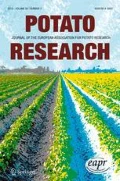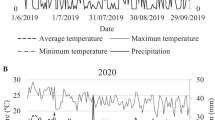Summary
The nature and extent of field resistance to late blight, and the effect of plant age and inoculum level on resistance components and host attributes, were studied on the Indian potato cultivars Kufri Chandramukhi, Kufri Jyoti, Kufri Badshah and Kufri Sherpa. Latent period, infection efficiency, colonization rate and sporulation were found to operate in cvs Kufri Jyoti, and Kufri Badshah. Based on component analysis cv. Kufri Jyoti was similar to or sometimes more resistant than Kufri Badshah. No correlation was observed between any of the host attributes and resistance to late blight, except that the erect canopy of Kufri Badshah was associated with its slow blighting rate. At high inoculum, colonization rate and total sporulation were increased but infection efficiency was decreased.
Similar content being viewed by others
References
Anonymous, 1947. The measurement of potato late blight.Transactions of the British Mycological Society 31: 140–141.
Bainbridge, A. & C.H. Dickinson, 1972. Effect of fungicides on the microflora of potato leaves.Transactions of the British Mycological Society 59: 31–41.
Black, W. & M.E. Gallegly, 1957. Screening ofSolanum species for resistance to physiologic races ofPhytopothora infestans.American Potato Journal 34: 273–281.
Carver, T.L.W. & A.J.H. Carr, 1977. Race non-specific resistance of oats to primary infection by mildew.Annals of Applied Biology 86: 29–36.
Ebercon, A., A. Blum & W.R. Jordan, 1977. A rapid colorimetric method for epiculticular wax content of sorghum leaves.Crop Science 17: 179–180.
Guzman, H.J., 1964. Nature of partial resistance of certain clones of threeSolanum species toPhytophthora infestans.Phytopathology 54: 1396–1404.
Hodgson, W.A., 1961. Laboratory testing of the potato for partial resistance toPhytophthora infestans.American Potato Journal 38: 259–264.
Kammermann, N., 1950–1951. Undersokningar rorande Potatisbladmoglet,Phytophthora infestans (Mont.) de Bary. I. Metodologisk undersokning, angaende provningen av Potatisblastens resistens mot bladmoglet. II. Sambandet mellan Potatisbladsaftens peroxidasaktivitet ochPhytophthora resistensen.Medd. Vaxtskyddsanst., Stockholm, 57: 44 pp. 1950; 58: 32 pp. (Review of Applied Mycology 31: 78–80).
Knutson, K.W., 1962. Studies on the nature of field resistance of the potato to late blight.American Potato Journal 39: 152–161.
Kroll, R.E. & C.J. Eide, 1981. Effect of inoculum concentration ofPhytohthora infestans on potato late blight.American Potato Journal 58: 153–161.
Lapwood, D.H. & R.K. McKee, 1966. Dose response relationships for infection of potato leaves by zoospores ofPhytophthora infestans.Transactions of the British Mycological Society 49: 679–686.
Latin R.H., 1980. Factors in potato that reduce the rate of epidemic increase of potato late blight. Ph.D. thesis. Pennsylvania State University, USA, 69 pp.
Lowings, P.H. & I.G. Acha, 1959. Some factors affecting growth ofPhytophthora infestans (Mont.) de Bary. I.P. infestans on living potato leaves.Transactions of the British Mycological Society 42: 491–501.
Neervoort, W.J. & J.E. Parlevliet 1978. Partial resistance of barley to leaf rustPuccinia hordei. V. Analysis of the components of partial resistance in eight barley cultivars.Euphytica 27: 33–39.
Parlevliet, J.E., 1975. Partial resistance of barley to leaf rustPuccinia hordei. I. Effect of cultivar and development stage on latent period.Euphytica 24: 21–27.
Russell, G.E., 1975. Depositon ofErysiphe graminis. f. sp.hordei conidia on barley varieties of differing growth habit.Phytopathologische Zeitschrift 84: 316–321.
Shaner, G. & R.E. Finney, 1977. The effect of nitrogen fertilization on the expression of slow mildewing resistance in Knox wheat.Phytopathology 67: 1051–1056.
Snedecor, G.W. & W.G. Cochran, 1956. Statistical Methods. The lowa State College Press, Ames. Iowa, USA, 525 p.
Umaerus, V., 1970. Studies on field resistance toPhytophthora infestans. 5. Mechanisms of resistance and application to potato breeding.Zeitschrift für Pflanzenzüchtung 63: 1–23.
Umaerus, V. & D. Lihnell, 1976. A laboratory method for measuring the degree of attack byPhytophthora infestans.Potato Research 19: 91–107.
Zaag, D.E. van der, 1959. Some observations on breeding for resistance toPhytophthora infestans.European Potato Journal 2: 278–286.
Author information
Authors and Affiliations
Rights and permissions
About this article
Cite this article
Singh, B.P., Bhattacharyya, S.K. Field resistance to late blight of four indian potato cultivars. Potato Res 38, 171–178 (1995). https://doi.org/10.1007/BF02357930
Accepted:
Issue Date:
DOI: https://doi.org/10.1007/BF02357930




